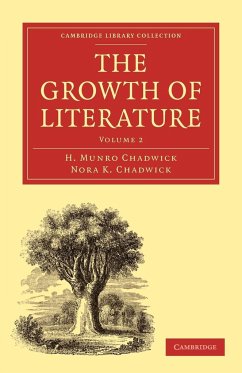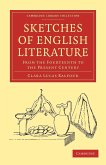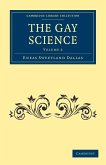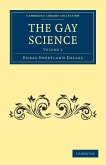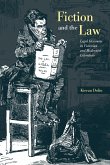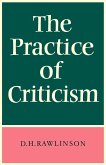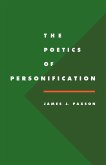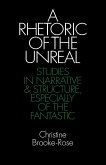- Broschiertes Buch
- Merkliste
- Auf die Merkliste
- Bewerten Bewerten
- Teilen
- Produkt teilen
- Produkterinnerung
- Produkterinnerung
A pioneering comparative study in three volumes, published 1932 1940, covering the development of world literature from Iceland to Polynesia.
Andere Kunden interessierten sich auch für
![Sketches of English Literature, from the Fourteenth to the Present Century Sketches of English Literature, from the Fourteenth to the Present Century]() Clara Lucas BalfourSketches of English Literature, from the Fourteenth to the Present Century46,99 €
Clara Lucas BalfourSketches of English Literature, from the Fourteenth to the Present Century46,99 €![The Gay Science - Volume 2 The Gay Science - Volume 2]() Eneas Sweetland DallasThe Gay Science - Volume 245,99 €
Eneas Sweetland DallasThe Gay Science - Volume 245,99 €![The Gay Science - Volume 1 The Gay Science - Volume 1]() Eneas Sweetland DallasThe Gay Science - Volume 145,99 €
Eneas Sweetland DallasThe Gay Science - Volume 145,99 €![Fiction and the Law Fiction and the Law]() Kieran DolinFiction and the Law52,99 €
Kieran DolinFiction and the Law52,99 €![The Practice of Criticism The Practice of Criticism]() D. H. RawlinsonThe Practice of Criticism28,99 €
D. H. RawlinsonThe Practice of Criticism28,99 €![The Poetics of Personification The Poetics of Personification]() James J. PaxsonThe Poetics of Personification27,99 €
James J. PaxsonThe Poetics of Personification27,99 €![A Rhetoric of the Unreal A Rhetoric of the Unreal]() Christine Brooke-RoseA Rhetoric of the Unreal70,99 €
Christine Brooke-RoseA Rhetoric of the Unreal70,99 €-
-
-
A pioneering comparative study in three volumes, published 1932 1940, covering the development of world literature from Iceland to Polynesia.
Hinweis: Dieser Artikel kann nur an eine deutsche Lieferadresse ausgeliefert werden.
Hinweis: Dieser Artikel kann nur an eine deutsche Lieferadresse ausgeliefert werden.
Produktdetails
- Produktdetails
- Verlag: Cambridge University Press
- Seitenzahl: 806
- Erscheinungstermin: 8. Oktober 2010
- Englisch
- Abmessung: 216mm x 140mm x 43mm
- Gewicht: 994g
- ISBN-13: 9781108016155
- ISBN-10: 1108016154
- Artikelnr.: 31810078
- Herstellerkennzeichnung
- Libri GmbH
- Europaallee 1
- 36244 Bad Hersfeld
- gpsr@libri.de
- Verlag: Cambridge University Press
- Seitenzahl: 806
- Erscheinungstermin: 8. Oktober 2010
- Englisch
- Abmessung: 216mm x 140mm x 43mm
- Gewicht: 994g
- ISBN-13: 9781108016155
- ISBN-10: 1108016154
- Artikelnr.: 31810078
- Herstellerkennzeichnung
- Libri GmbH
- Europaallee 1
- 36244 Bad Hersfeld
- gpsr@libri.de
Preface
Corrigenda
Explanatory note on 'types' and 'saga'
Part I. Russian Oral Literature: 1. Introduction. Oral tradition and writing
2. Heroic poetry. The Byliny
3. The heroic milieu. Individualism in the heroic poems
4. Historical and unhistorical elements in the Byliny
5. The texts
6. Saga
7. Non-heroic poetry. The Stikhi (1)
8. Poetry relating to scriptural subjects and to the saints of the Greek church. The Stikhi (2)
9. Post-heroic, antiquarian, gnomic and descriptive poetry and saga
10. Poetry relating to unspecified individuals
11. The recitation and composition of heroic poetry and saga. The Skaziteli
12. The recitation and composition of religious poetry. The Kalêki
13. The popular poet and story-teller
List of abbreviations used in Part I
Part II. Yugoslav Oral Poetry: 1. Introduction. Literature and writing
2. Heroic poetry
3. Non-heroic poetry
4. The heroic milieu. Individualism
5. Unhistorical elements in heroic poetry
6. Poetry relating to supernatural beings
7. Poetry relating to unspecified individuals
8. The remaining categories. (1) Antiquarian poetry, (2) Gnomic, descriptive and mantic poetry
9. The texts
10. Recitation and composition. The poet
Part III. Early Indian Literature: 1. Introduction. Literature and writing
2. Heroic poetry
3. The heroic milieu. Individualism
4. Non-heroic poetry and saga
5. Historical and unhistorical elements in heroic poetry
6. Poetry and saga relating to deities
7. Antiquarian learning
8. Gnomic and descriptive poetry
9. Poetry (and prose) relating to unspecified individuals
10. Mantic poetry and prose
11. The texts
12. Recitation and composition. The author
Part IV. Early Hebrew Literature: 1. Introduction. Literature and writing
2. The heroic age. Heroic saga and poetry
3. Non-heroic saga and poetry
4. The heroic milieu. Individualism
5. Historical and unhistorical elements in heroic poetry
6. Antiquarian learning
7. Theological and mantic literature
8. Gnomic and descriptive literature. Literature relating to unspecified individuals
9. The texts. Recitation and composition
10. The author
Index.
Corrigenda
Explanatory note on 'types' and 'saga'
Part I. Russian Oral Literature: 1. Introduction. Oral tradition and writing
2. Heroic poetry. The Byliny
3. The heroic milieu. Individualism in the heroic poems
4. Historical and unhistorical elements in the Byliny
5. The texts
6. Saga
7. Non-heroic poetry. The Stikhi (1)
8. Poetry relating to scriptural subjects and to the saints of the Greek church. The Stikhi (2)
9. Post-heroic, antiquarian, gnomic and descriptive poetry and saga
10. Poetry relating to unspecified individuals
11. The recitation and composition of heroic poetry and saga. The Skaziteli
12. The recitation and composition of religious poetry. The Kalêki
13. The popular poet and story-teller
List of abbreviations used in Part I
Part II. Yugoslav Oral Poetry: 1. Introduction. Literature and writing
2. Heroic poetry
3. Non-heroic poetry
4. The heroic milieu. Individualism
5. Unhistorical elements in heroic poetry
6. Poetry relating to supernatural beings
7. Poetry relating to unspecified individuals
8. The remaining categories. (1) Antiquarian poetry, (2) Gnomic, descriptive and mantic poetry
9. The texts
10. Recitation and composition. The poet
Part III. Early Indian Literature: 1. Introduction. Literature and writing
2. Heroic poetry
3. The heroic milieu. Individualism
4. Non-heroic poetry and saga
5. Historical and unhistorical elements in heroic poetry
6. Poetry and saga relating to deities
7. Antiquarian learning
8. Gnomic and descriptive poetry
9. Poetry (and prose) relating to unspecified individuals
10. Mantic poetry and prose
11. The texts
12. Recitation and composition. The author
Part IV. Early Hebrew Literature: 1. Introduction. Literature and writing
2. The heroic age. Heroic saga and poetry
3. Non-heroic saga and poetry
4. The heroic milieu. Individualism
5. Historical and unhistorical elements in heroic poetry
6. Antiquarian learning
7. Theological and mantic literature
8. Gnomic and descriptive literature. Literature relating to unspecified individuals
9. The texts. Recitation and composition
10. The author
Index.
Preface
Corrigenda
Explanatory note on 'types' and 'saga'
Part I. Russian Oral Literature: 1. Introduction. Oral tradition and writing
2. Heroic poetry. The Byliny
3. The heroic milieu. Individualism in the heroic poems
4. Historical and unhistorical elements in the Byliny
5. The texts
6. Saga
7. Non-heroic poetry. The Stikhi (1)
8. Poetry relating to scriptural subjects and to the saints of the Greek church. The Stikhi (2)
9. Post-heroic, antiquarian, gnomic and descriptive poetry and saga
10. Poetry relating to unspecified individuals
11. The recitation and composition of heroic poetry and saga. The Skaziteli
12. The recitation and composition of religious poetry. The Kalêki
13. The popular poet and story-teller
List of abbreviations used in Part I
Part II. Yugoslav Oral Poetry: 1. Introduction. Literature and writing
2. Heroic poetry
3. Non-heroic poetry
4. The heroic milieu. Individualism
5. Unhistorical elements in heroic poetry
6. Poetry relating to supernatural beings
7. Poetry relating to unspecified individuals
8. The remaining categories. (1) Antiquarian poetry, (2) Gnomic, descriptive and mantic poetry
9. The texts
10. Recitation and composition. The poet
Part III. Early Indian Literature: 1. Introduction. Literature and writing
2. Heroic poetry
3. The heroic milieu. Individualism
4. Non-heroic poetry and saga
5. Historical and unhistorical elements in heroic poetry
6. Poetry and saga relating to deities
7. Antiquarian learning
8. Gnomic and descriptive poetry
9. Poetry (and prose) relating to unspecified individuals
10. Mantic poetry and prose
11. The texts
12. Recitation and composition. The author
Part IV. Early Hebrew Literature: 1. Introduction. Literature and writing
2. The heroic age. Heroic saga and poetry
3. Non-heroic saga and poetry
4. The heroic milieu. Individualism
5. Historical and unhistorical elements in heroic poetry
6. Antiquarian learning
7. Theological and mantic literature
8. Gnomic and descriptive literature. Literature relating to unspecified individuals
9. The texts. Recitation and composition
10. The author
Index.
Corrigenda
Explanatory note on 'types' and 'saga'
Part I. Russian Oral Literature: 1. Introduction. Oral tradition and writing
2. Heroic poetry. The Byliny
3. The heroic milieu. Individualism in the heroic poems
4. Historical and unhistorical elements in the Byliny
5. The texts
6. Saga
7. Non-heroic poetry. The Stikhi (1)
8. Poetry relating to scriptural subjects and to the saints of the Greek church. The Stikhi (2)
9. Post-heroic, antiquarian, gnomic and descriptive poetry and saga
10. Poetry relating to unspecified individuals
11. The recitation and composition of heroic poetry and saga. The Skaziteli
12. The recitation and composition of religious poetry. The Kalêki
13. The popular poet and story-teller
List of abbreviations used in Part I
Part II. Yugoslav Oral Poetry: 1. Introduction. Literature and writing
2. Heroic poetry
3. Non-heroic poetry
4. The heroic milieu. Individualism
5. Unhistorical elements in heroic poetry
6. Poetry relating to supernatural beings
7. Poetry relating to unspecified individuals
8. The remaining categories. (1) Antiquarian poetry, (2) Gnomic, descriptive and mantic poetry
9. The texts
10. Recitation and composition. The poet
Part III. Early Indian Literature: 1. Introduction. Literature and writing
2. Heroic poetry
3. The heroic milieu. Individualism
4. Non-heroic poetry and saga
5. Historical and unhistorical elements in heroic poetry
6. Poetry and saga relating to deities
7. Antiquarian learning
8. Gnomic and descriptive poetry
9. Poetry (and prose) relating to unspecified individuals
10. Mantic poetry and prose
11. The texts
12. Recitation and composition. The author
Part IV. Early Hebrew Literature: 1. Introduction. Literature and writing
2. The heroic age. Heroic saga and poetry
3. Non-heroic saga and poetry
4. The heroic milieu. Individualism
5. Historical and unhistorical elements in heroic poetry
6. Antiquarian learning
7. Theological and mantic literature
8. Gnomic and descriptive literature. Literature relating to unspecified individuals
9. The texts. Recitation and composition
10. The author
Index.

